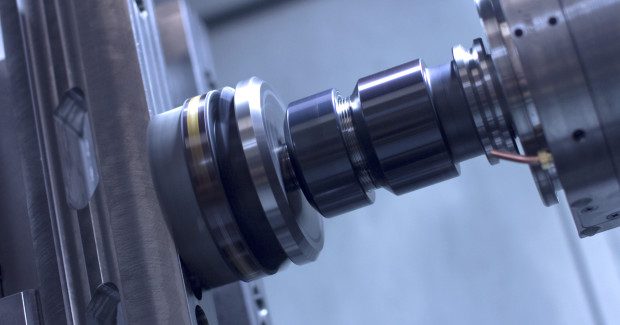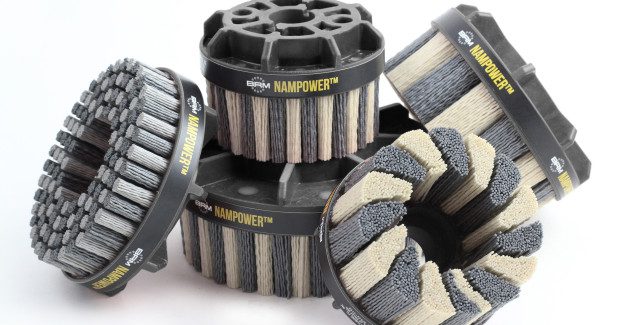Finishing Touch
New developments with in-line abrasive tooling used on machine tools allows shops to replace grinders, polishing heads, chamfering tools, hand deburring and other secondary operations.
Posted: February 10, 2015
One of the more noteworthy advancements in tools for in-line machine deburring, edge radius, cleaning and other surface finishing applications is the abrasive nylon brush. Now, with new advances in abrasive technology, machining center operators are able to complete surface finishing simultaneously with other machining operations, to speed product completion, improve on quality and save on off-line finishing time and costs.
For automated applications abrasive nylon brushes are densely bristled compositions of abrasive and flexible nylon filaments that are attached to a machine-mountable base. Each filament contains grit particles that provide machining actions such as deburring, cleaning, edge blending, polishing and other surface finishing functions. Although there are a variety of sizes and shapes available, when configured for CNC or robotic applications typically thousands of nylon filaments containing the appropriate grit are affixed in clusters to a single base that is mounted (e.g., via drive arbor) to the machining equipment.
Common applications for these tools include deburring, cleaning and rust removal, preparing surfaces for plating or painting, spot finishing, and polishing. Tools they commonly replace are grinders, polishing heads, chamfering tools, hand deburring and other equipment. “The abrasive filaments work like ‘flexible files,’ conforming to workpiece contours, wiping and filing across part edges and surfaces to deliver maximum burr removal rates along with an ideal surface finish,” says Eric Sun, the founder of Orange Vise Company LLC (Union City, CA), a machine shop and machine tool manufacturer.
A quality abrasive nylon brush is very durable and self sharpening, providing excellent performance and wear life. Because of linear filament construction, as these brushes come in contact with work surfaces during machining use, filament grit wears off, exposing new cutting particles. In that manner the brush continues to be sharp. Also, unlike the bristles of metal brushes, the nylon fibers are not prone to deforming or breaking off. “A problem with wire brushes is that the bristles tend to shoot out, they don’t really stay put,” explains Sun. “When they bend, they often stay permanently deformed.”
In fact, abrasive nylon fibers offer improved compliancy to the contours of even very complex workpieces, preventing damage while ensuring consistent finishing quality. Sun notes that using abrasive nylon brushes can also eliminate the need to use other tools in automated applications, such as chamfer tools for deburring, and face mills for surface polishing. “This tool is also applicable when tumbling would be required to achieve extensive deburring,” he adds. “While tumbling can certainly produce a nice surface finish, it can also create minor defects on parts because they come into contact with one another. Although it may take an extra minute or two to completely finish workpieces in the machine using the abrasive nylon brush technology, in my experience it is usually worth it in terms of quality and costs.”
Among a variety of abrasive nylon brush tools available, Sun has adopted the NamPower™ line offered by Brush Research Manufacturing Co., Inc. (Los Angeles, CA). “We have two different patterns of these brushes, one is called the Dot-Type, while the other is called Turbine Type,” he says. “We use the Dot Style for deburring highly contoured workpieces with a lot of peaks and valleys. It is particularly economical for light deburring operations when short cycle times are important.”
Sun adds that the Turbine Style brush has a more aggressive pattern and is used mainly for medium and heavy deburring applications. This style of brush is better suited towards flatter workpieces with fewer contours and can be used to simulate a milled finish without actually removing any material.
Both of these styles of abrasive nylon brushes are available in a variety of abrasive types and grit selections to work with materials including a wide range of metals, super alloys, plastics, advanced composites, metal matrix and ceramics. Both brush styles are available in three different diameters and two different trim lengths to suit most applications and can be used to automate processes on VMC, HMC, CNC and robotic applications, producing a consistent finish from part to part.
Composed of flexible abrasive nylon filaments bonded to a fiber reinforced thermoplastic base, NamPower abrasive disc brushes contain a unique combination of both ceramic and silicon carbide filaments. Although there are other abrasive nylon filament products that utilize silicon carbide or ceramic, it is the combination of both in one tool that makes this type of abrasive nylon brushes unique. The ceramic abrasive is engages for material removal, but tends to cut a bit coarse. The silicon carbide acts as a buffer to the cutting action. The end result is deburring and surface finishing in a single operation.
These brushes work well with non-ferrous, cast iron, mild steel and ductile iron, stainless and alloy steels, titanium and high nickel alloys. “We weren’t expecting to use brushes so much, but we’re finding more and more uses for them,” says Sun. “We use the same brushes for aluminum, steel, cast iron and stainless steel without having to swap them out very often.”
One such application, and one of its primary purposes, is for edge blending. According to Sun, Orange Vise utilizes a variety of deburring tools, including a 45 deg chamfer. Although the tool doesn’t typically leave a burr, when it begins to wear – even slightly – it can. Based on this possibility, the shop required an employee to inspect each part and handle any burrs by hand. Now the company automatically deburrs chamfered holes and edges using the NamPower abrasive disc brush in addition to chamfering with a 45 deg milling cutter. The redundant operation of brushing adds minimal cycle time, improves surface finish, and ensures burr-free parts.
Sun adds that shops using CNC and other automated machining equipment can benefit significantly by adopting this type of abrasive brush technology. “With this type of equipment working into the evenings and weekends, it’s really desirable to get the finishing operations done straight out of the machine,” he says. “While some shops running three shifts – if they have the personnel and the capacity – they may still prefer to use their machines producing parts – not deburring. But for many operations it’s actually more efficient to let the machine do everything online, so that the part comes out ready to wash and box for delivery to the customer. That can really make a big difference, because you’re using any unutilized machining hours, plus you’re automatically producing parts with consistently high quality.”
New developments are also on the horizon, with several new products featuring diamond and ceramic impregnated filaments set to be released into the market. One new series of affordable diamond filament wheel brushes is designed to finish harder materials like ceramic and carbide. Several new end brush designs featuring ceramic filament will be available in smaller diameters to provide the benefits of abrasive nylon finishing and small parts and recesses.
Orange Vice Company LLC, 32920 Alvarado-Niles Road, Suite 250, Union City, CA 94587, 714-482-3952, info@orangevise.com, www.orangevise.com.
Brush Research Mfg. Co., Inc., 4642 Floral Drive, Los Angeles, CA 90022, 323-261-2193, Fax: 323-268-6587, info@brushresearch.com, www.brushresearch.com.






